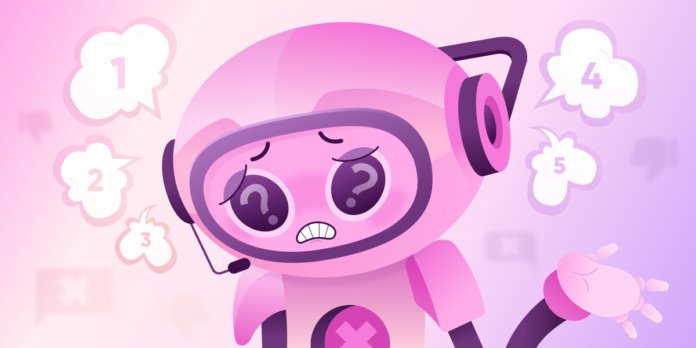How Poorly Implemented Bots Fail, and why Glia Virtual Assistants Don’t
A great chatbot can be a game changer for your digital customer experience: It can solve problems and answer questions automatically without forcing a user to rely on your live service reps, keeping the user happy and your customer support staff free to focus on high-involvement questions. However, a chatbot that fails to be helpful can end up being harmful for your overall customer satisfaction, not only defeating the purpose of the solution but making it counter-intuitive as well. There’s a number of ways a chatbot can sour the user experience: here’s five common failings seen frequently in poorly designed bots.
1. It Didn’t Know How to Answer Their Question
The most deceptively simple problem, your chatbot just didn’t know the answer. Be it due to a lack of data or poor coverage of information, the chatbot couldn’t give an answer to their question. It might even be because the bot couldn’t decipher normal, natural language like users are used to using in other text based channels. Whatever the cause, the result is an incredibly unsatisfying interaction that leaves the user feeling frustrated.
2. It Didn’t Understand the Question Being Asked
Maybe your bot has all the answers, but what good is that if it doesn’t understand the questions themselves? Some chatbot solutions struggle to know what question a user is asking it due to a poor understanding of natural language. If your chatbot can’t tell what’s being asked of it, it won’t know which answer to give and when. This either leads to incorrect answers, or no answers at all. It’s critical that a chatbot be trained in interpreting natural language to avoid trapping the user in this situation.
3. It Gave Too Long and Complicated of an Answer
Nobody wants a five paragraph answer to a one sentence question. If your user has to wade through a sea of useless information to find the results they need, your bot has a problem with delivering concise answers. This occurs often when a chatbot is unable to hone in on granularity within wide areas of discussion, causing it to need to provide lengthy answers to cover a variety of different smaller questions within a broader topic. This makes your bot feel clumsy and unintelligent, and frustrates the user. Chatbots need to intelligently understand user goals to surface the right responses.
4. It Couldn’t Remember What Was Said Earlier
Context is what makes conversations feel human, and nothing makes a chatbot feel more like an algorithm than forgetting what it was told a few messages ago. Poorly implemented solutions are unable to retain information told to them by users, meaning that users may have to enter the same information multiple times to get the help they need. Making the user repeat themselves constantly is a fast way to have them wishing they could be talking to a live person instead, wasting everyone’s time in the process.
5. It Didn’t Have Great Data to Work With
Data is what makes a chatbot such a powerful tool, but the data you give it has to be top notch: It’s about quality over quantity. No matter how accurate your model is, it can only be as good as the data provided. Organizing the right content and delivering it in a meaningful way are both key to optimal user experiences.
How Glia Virtual Assistants Built Into Digital Customer Service Makes the Difference
To make sure you avoid these common chatbot pitfalls, you need to get a virtual assistant with high-quality data, domain expertise, and proven conversational banking abilities. Glia Virtual Assistants (GVAs) has everything needed to avoid these common pitfalls:
- Trained on over 800 proven retail banking workflows, GVAs can recognize almost any question that a user in the financial services industry could ask it.
- Advanced machine learning powered by high-quality data and trained on millions of banking conversations. It’s smart: smart because its AI core has learned for years based on user chatbot inquiries.
- Built directly into Glia’s Digital Customer Service platform, GVAs are able to seamlessly hand-off conversations to live reps when they’re needed most. Full conversation context transfers along with them, avoiding the user needing to repeat information or the rep needing to ask “how can I help you?”
- Continuous learning and natural language improvement across all platforms: the more people use it, the better it gets.
A well-designed virtual assistant improves the customer service experience for both your end-users and your employees.





